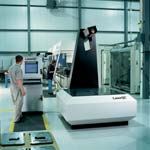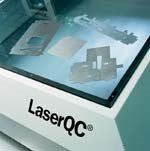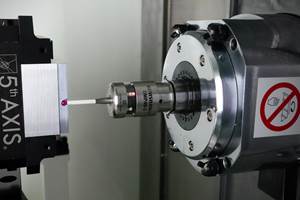Looking Beyond Inspection
For this shop, the only fly in their ointment was quality inspection. When the shop first started producing parts in the summer of 2000, punched blanks had to be sent a few miles up the road, where quality technicians could check setups with a coordinate measuring machine. The round trip could take as much as 2 days.
Mack Molding's new sheet metal operation was fast coming up on its first open house, and the shop was about 99 percent operational. That may be pretty good for most new operations, but when you're part of Mack Molding, 99 percent isn't good enough.
Mack (Arlington, Vermont) is a contract manufacturer for engineered injection-molded plastic parts. This department was Mack's first move into sheet metal fabrication.
The shop had brand new Trumpf punch centers and brakes, a Genesis robotic plasma welder and a pair of Tecna 80KVA resistance welders, plus a Haeger hardware insertion press. For Bill Kelley, manufacturing engineer, the only fly in the ointment was quality inspection. When the shop first started producing parts in the summer of 2000, punched blanks had to be sent a few miles up the road to Mack's East Arlington plant, where quality technicians could check setups with a coordinate measuring machine. The round trip could take as much as 2 days, and if there were problems in the setup 2 days worth of work might have to be scrapped.
Mr. Kelley took his problem to Rick Graham of Robert E. Morris Ltd., (Farmington, Connecticut) the distributor who had supplied most of the production equipment for the shop. With an inspection system on site, Mr. Kelley could shorten cycle time on first-article inspections and increase productivity. CMM inspection was ruled out as too labor intensive to make a significant difference. Mr. Kelley and Mr. Graham discussed a seven-camera optical inspection system as well as the new laser inspection systems from Virtek (Waterloo, Ontario, Canada). "There was no question," Mr. Graham recalls, "that nothing less than the best would do. That's the way Mack does everything."
Between the optical and laser technologies, Mr. Kelley was ready to order the camera-based system. Then the open house became a factor.
"We couldn't get the optical system delivered for 12 weeks or more," Mr. Kelley explains. "Plus there was setup time. But I wanted to have the shop at 100 percent when our customers came through. We had set a goal and made commitments to have a system under our roof by that time, and I intended to stick to it."
While laser inspection was less familiar than optical inspection, Mr. Graham assured Mr. Kelley that the Virtek system fit with Mack's philosophy.
Mr. Graham contacted Glenn Crolly at the Industrial Imaging division of Virtek Vision, and he explained the problem. Glenn no sooner hung up the phone than he had the wheels in motion to get a LaserQC system packaged up and put on a truck for a direct drive to Arlington. Mr. Kelley recalls, "We called on Friday, and the LaserQC was promised for the next Thursday. It arrived 2 days early." Right behind the system came the Virtek installation crew to set up and calibrate the system. A day later, before a week was out, the LaserQC was up and running.
The LaserQC is located right on the shop floor, where operators can get to it quickly. The laser head quickly scans the flat part, and its computer monitor displays it as an outline image. The image is overlaid with the corresponding CAD drawing, and color codes indicate whether or not the scanned part is within tolerances. "As fast as you can lay the part down, you get the information you need, which means we can run more inspections without interrupting production," Mr. Kelley says. Mack can now do its own first-article inspections for every setup, and again at the beginning of every shift, then do additional in-process checks throughout the production run.
Mr. Kelley admits that, at first, his staff was skeptical about whether a system as easy and as fast as the LaserQC could also be as accurate as the more familiar systems. "So we double checked with the CMM equipment. But we never once found a case where the LaserQC passed an out-of-spec part." The tests did discover that, in a couple of instances, the laser system had produced false fails—good parts that it saw as bad. Virtek was called in to investigate, and the culprit was found to be a vibration in the floor that could introduce a slight blurring in the laser scan. Working with the Mack staff, Virtek added damping to isolate the LaserQC from the vibration, and the false fails came to an end.
The productivity gains that Mr. Kelley has seen are partly a result of the LaserQC's simplicity. "Having more people qualified to do inspections is a huge advantage. Now, our off-shift can check their own setups without waiting for specially trained technicians to give them the go-ahead. If anything is wrong—if a wrong tool is in place—the LaserQC captures it immediately."
In the time Mr. Graham has been distributing Virtek systems, he has seen how they can have a positive impact throughout the shop. "The LaserQC has actually uncovered issues for quality assurance that go beyond the scope of first-article inspections. People naturally tend to do what's easiest, and there are a lot of ways to mask their quality problems—especially when it comes to preventive maintenance. The LaserQC can automatically generate a continuous history of your part inspections, complete with scanned images, so you can track when a machine is drifting and then take the necessary steps. When a tool starts to leave jagged edges, the system's software ‘rounds up' to the largest error and shows you the problem clearly. It leaves nothing to question—you see where your problems are, and you fix them. The same documentation also simplifies your shop's SPC and ISO/QS reporting, whether it's for internal quality control or for customers."
When Mr. Crolly speaks of LaserQC installations, the conversation again turns quickly to shop processes. "Calibrating the equipment and training the operators really is very simple. So we put more of our attention on partnering with our customers to help them establish procedures in the shop to capture the full value of the system—how to integrate with customer requirements, PM, SPC, and so on."
Mr. Kelley agrees that the inspection system has emerged as a valuable asset. Beyond meeting the basic need for quality assurance, faster inspections result in a "fatter pipeline" to deliver more parts in less time. The quick setup of LaserQC also speeds up its ROI, providing Mack with weeks or months of productivity to start earning its keep while other systems would still be using shop time. "The LaserQC automatically self-calibrates every time you start it up," Mr. Kelley says. "There's no cost for scheduled downtime, and it gives you some extra confidence in your inspections every day.
When Mack's sheet metal operation hosted its open house, the LaserQC was there to demonstrate the company's commitment to assured accountability for quality standards.
Related Content
What Should Machinists Know About In-Machine Probing?
In-machine probing doesn’t reach the power of CMMs but can still be useful for pre- and mid-process control, as well as for “rough screening” of parts.
Read More5 Things CNC Operators Must Know About Sizing Adjustments
For CNC operators, sizing adjustment is an essential skill. Keep these points in mind when training new CNC users.
Read MoreChoosing the Correct Gage Type for Groove Inspection
Grooves play a critical functional role for seal rings and retainer rings, so good gaging practices are a must.
Read MoreHow to Choose the Right Cut Off When Measuring Roughness
Measurement results for surface finishing parameters can vary depending on the filter parameter (Lc), also known as the cutoff.
Read MoreRead Next
The Cut Scene: The Finer Details of Large-Format Machining
Small details and features can have an outsized impact on large parts, such as Barbco’s collapsible utility drill head.
Read More3 Mistakes That Cause CNC Programs to Fail
Despite enhancements to manufacturing technology, there are still issues today that can cause programs to fail. These failures can cause lost time, scrapped parts, damaged machines and even injured operators.
Read More









.png;maxWidth=300;quality=90)


.png;maxWidth=300;quality=90)

















